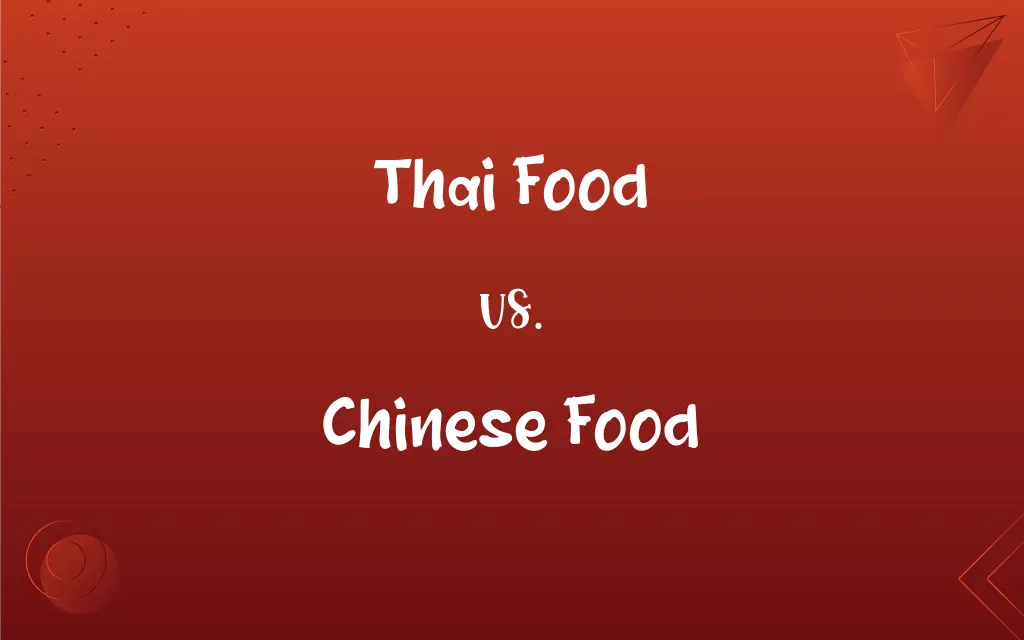Thai Food vs. Chinese Food: What's the Difference?
Edited by Janet White || By Harlon Moss || Updated on October 13, 2023
Thai food emphasizes a balance of five key flavors and often uses ingredients like coconut milk and basil, while Chinese food focuses on varied flavors and textures, often involving ingredients like soy sauce and ginger.

Key Differences
Thai food universally embraces a symphony of flavors, skillfully combining sweet, sour, spicy, bitter, and salty to create a harmonious taste. On the other hand, Chinese food utilizes varied flavors, often embracing sweet, sour, and umami, and might focus on showcasing one predominant flavor in certain dishes.
Thai food commonly integrates a variety of fresh herbs and spices like basil, cilantro, and chilies into its dishes. In contrast, Chinese food frequently employs a combination of dried and fresh ingredients, such as dried mushrooms, fresh ginger, and garlic, offering a different flavor palette.
Notably, Thai food has a tendency to utilize lighter, rice-based noodles in dishes like Pad Thai. Conversely, Chinese food offers a wide array of noodle types, from rice noodles to wheat noodles, with varied thickness and texture, accommodating a broader range of noodle dishes.
Thai food often employs coconut milk as a base for its curries, lending a creamy, rich texture and slightly sweet flavor. Chinese food, while it also includes curries (particularly in Indian-influenced regions), generally opts for a soy or bean paste base for savory dishes, providing a umami, salty flavor.
While both Thai and Chinese food utilize rice as a staple, Thai food often features jasmine rice, with its distinctive floral aroma. Chinese food, in contrast, primarily uses long-grain rice, sticky rice, or even medium-grain rice, depending on the regional cuisine, each with its own characteristic texture and flavor.
ADVERTISEMENT
Comparison Chart
Flavor Profile
Balances sweet, sour, spicy, bitter, and salty.
Varied, with emphasis on sweet, sour, and umami.
Common Herbs
Fresh basil, cilantro, and mint.
Often uses fresh and dried ginger and garlic.
Noodle Type
Predominantly lighter, rice-based noodles.
Includes a wide variety, from rice to wheat.
Curry Base
Frequently uses coconut milk.
May use soy or bean paste, depending on the region.
Rice Varieties
Often uses jasmine rice.
Utilizes various types, like long-grain or sticky.
ADVERTISEMENT
Thai Food and Chinese Food Definitions
Thai Food
Characterized by its vibrant and robust spicy dishes.
Thai food can be incredibly spicy, especially dishes like Som Tum (papaya salad).
Chinese Food
Recognized for its use of soy sauce, ginger, and garlic as base flavors.
In Chinese food, soy sauce is often used to add a savory and umami flavor.
Thai Food
Renowned for dishes like Pad Thai, Tom Yum, and Massaman curry.
When ordering Thai food, Pad Thai is a popular choice among many diners.
Chinese Food
Diverse cuisine with an emphasis on balanced flavors and textures.
Chinese food includes a wide array of flavors from various regional cuisines.
Thai Food
A cuisine featuring a balance of five flavors: sweet, spicy, sour, bitter, and salty.
The Thai food menu often contains a variety of colorful curries.
Chinese Food
Noted for cooking techniques like stir-frying, steaming, and deep-frying.
Chinese food often involves stir-frying vegetables and meats at high heat.
Thai Food
Typically includes ingredients like coconut milk, lime juice, and fish sauce.
Thai food often utilizes coconut milk to create creamy and rich curries.
Chinese Food
Characterized by staple grains like rice and noodles in many dishes.
In many Chinese food dishes, rice is served as a base to accompany saucy entrees.
Thai Food
Known for its liberal use of fresh herbs like basil, cilantro, and mint.
Thai food often incorporates basil to create a unique, aromatic flavor in various dishes.
Chinese Food
Known for dim sum, a meal of small, flavorful dishes shared among diners.
When eating Chinese food, trying a variety of dim sum provides numerous flavors.
FAQs
What is the main flavor profile of Thai food?
Thai food typically balances sweet, sour, spicy, bitter, and salty flavors.
Is Chinese food always spicy?
No, Chinese food includes a range of dishes, from mild to spicy, depending on the region.
Does Chinese food incorporate a lot of seafood?
Yes, especially in coastal regions where seafood is abundant and fresh.
How significant is rice in Chinese food?
Extremely; rice is a staple in Chinese cuisine, featured in many meals.
What is a renowned Thai dessert?
Mango with sticky rice is a beloved Thai dessert.
Is vegetarian eating common in Thai food?
Yes, Thai cuisine offers various vegetarian dishes and adaptations.
Is Thai food influenced by other cuisines?
Yes, it has influences from Chinese, Indian, and other Asian cuisines.
Is tea significant in Chinese food culture?
Yes, tea is deeply embedded in Chinese culture and cuisine.
Which Thai food is usually recommended for spice lovers?
Dishes like Som Tum and Tom Yum Goong are notably spicy.
What is a popular meat used in Chinese food?
Pork is widely used in various Chinese dishes.
Does Thai food use dairy?
Rarely, Thai dishes commonly use coconut milk instead of dairy.
Are noodles prevalent in Thai food?
Yes, dishes like Pad Thai and Drunken Noodles are well-known.
Are dumplings significant in Chinese food?
Absolutely, dumplings are fundamental and come in various styles.
What are bao buns in Chinese food?
Bao buns are steamed, filled buns, often containing meat or vegetables.
Is Pad Thai originally from Thailand?
Yes, Pad Thai is a Thai stir-fried noodle dish and is widely popular.
What is a common Thai appetizer?
Spring rolls are a common appetizer in Thai cuisine.
Is Peking Duck a famous Chinese food?
Yes, Peking Duck is a renowned Chinese dish known for its crispy skin.
Is tofu commonly used in Chinese food?
Yes, tofu is prevalent in various forms in Chinese cuisine.
What's a common Chinese food breakfast item?
Congee, a type of rice porridge, is common for breakfast.
How is street food perceived in Thailand?
Thai street food is popular, offering various affordable and tasty options.
About Author
Written by
Harlon MossHarlon is a seasoned quality moderator and accomplished content writer for Difference Wiki. An alumnus of the prestigious University of California, he earned his degree in Computer Science. Leveraging his academic background, Harlon brings a meticulous and informed perspective to his work, ensuring content accuracy and excellence.
Edited by
Janet WhiteJanet White has been an esteemed writer and blogger for Difference Wiki. Holding a Master's degree in Science and Medical Journalism from the prestigious Boston University, she has consistently demonstrated her expertise and passion for her field. When she's not immersed in her work, Janet relishes her time exercising, delving into a good book, and cherishing moments with friends and family.































































